Vision: receptive fields & threshold for seeing
0.0(0)
Card Sorting
1/13
Earn XP
Description and Tags
Study Analytics
Name | Mastery | Learn | Test | Matching | Spaced |
|---|
No study sessions yet.
14 Terms
1
New cards
Define the term ‘receptive field’
**Receptive field (RF)**: area of sensory surface which, if stimulated, will affect a neuron's state
RF area is inversely proportional to acuity (central vision detailed, periphery not)
RF area is inversely proportional to acuity (central vision detailed, periphery not)
2
New cards
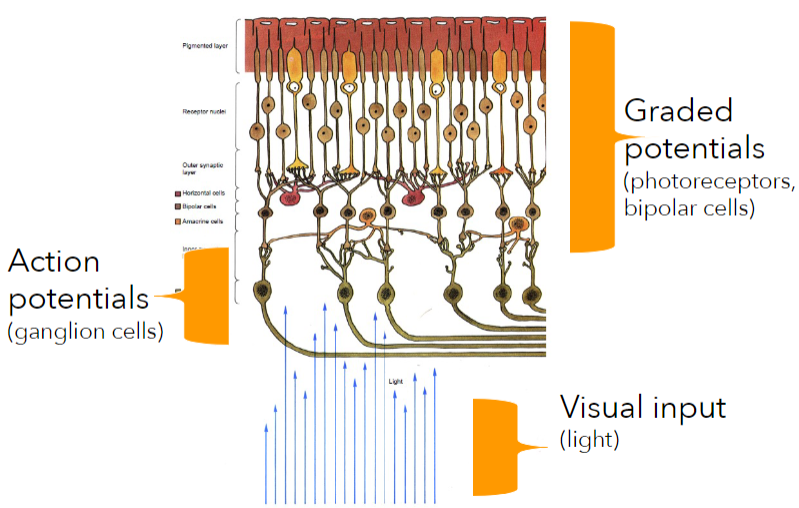
Describe receptive fields in the retina + research
* Light travels to back of eye, encoded as graded potentials, converted to action potentials
* Spatially concentric receptive fields of retinal ganglion cells
* *A spatially concentric cell encodes information corresponding to a location and its surroundings in an opposite way (it responds not only to a specific location but also – inversely - to its surroundings)*
* Cells affixed to point A will excite when light reaches A,
but inhibit when light reaches point B, surrounding point A
* Spatially concentric receptive fields of retinal ganglion cells (Barlow 1953; Kuffler 1953)
* For on-centre response cells,
* Light shown to central spot- high frequency of action potentials
* Light shown to periphery- inhibition of action potentials
* Spatially concentric receptive fields of retinal ganglion cells
* *A spatially concentric cell encodes information corresponding to a location and its surroundings in an opposite way (it responds not only to a specific location but also – inversely - to its surroundings)*
* Cells affixed to point A will excite when light reaches A,
but inhibit when light reaches point B, surrounding point A
* Spatially concentric receptive fields of retinal ganglion cells (Barlow 1953; Kuffler 1953)
* For on-centre response cells,
* Light shown to central spot- high frequency of action potentials
* Light shown to periphery- inhibition of action potentials
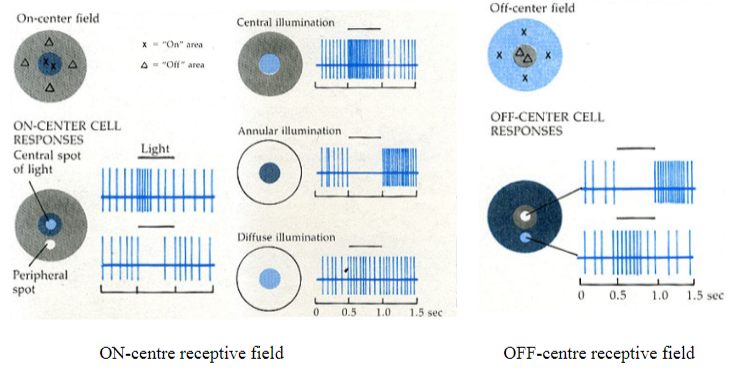
3
New cards
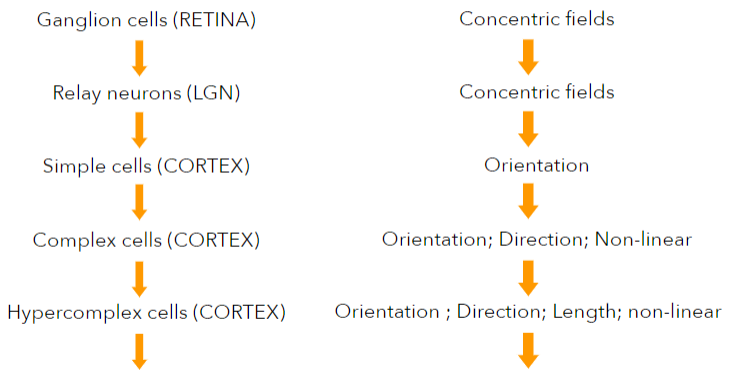
Describe briefly the visual pathway
* Information conveyed by concentric receptive fields travels through the visual pathway and integrates
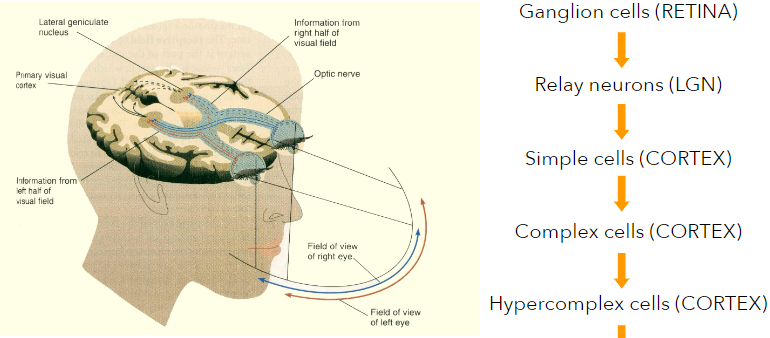
4
New cards
![Describe simple cells in the cat visual cortex \[Hubel & Wiesel\]](https://knowt-user-attachments.s3.amazonaws.com/9e5adf9e90534be2b5e1e8a472768d72.jpeg)
Describe simple cells in the cat visual cortex \[Hubel & Wiesel\]
* Orientation tuned
* Linear (response is simple sum of excitation and inhibition of entire receptive field)
* Linear (response is simple sum of excitation and inhibition of entire receptive field)
5
New cards
![Describe complex cells in the cat visual cortex \[Hubel & Wiesel\]](https://knowt-user-attachments.s3.amazonaws.com/f600940dcd884ff0b0338f9ab6e1634e.jpeg)
Describe complex cells in the cat visual cortex \[Hubel & Wiesel\]
* Orientation tuned
* Often directionally selective
* Non-linear (response is not simply the sum of excitation and inhibition in the receptive field)
* Often no distinctive on- or off- regions
* Often directionally selective
* Non-linear (response is not simply the sum of excitation and inhibition in the receptive field)
* Often no distinctive on- or off- regions
6
New cards
![Describe hypercomplex cells in the cat visual cortex \[Hubel & Wiesel\]](https://knowt-user-attachments.s3.amazonaws.com/4565540d266e49b18f94fdca620b92da.jpeg)
Describe hypercomplex cells in the cat visual cortex \[Hubel & Wiesel\]
* Orientation tuned
* Often directional
* Non-linear
* End-stopped (selective for length)
* Often directional
* Non-linear
* End-stopped (selective for length)
7
New cards
Either RFs are templates (construct perceptually relevant features) or RFs are filters (detect change or continuity):
RFs as templates
RFs as templates
Higher information travels in this hierarchy as it gets more complex and abstract. RF areas tend to increase through successive levels of processing hierarchy in the brain.
* Suggests information pooling
Issues with this theory:
* Implementation- circuitry not traced
* More overlap between regions than implied
* Information feedback, not only feedforward
* Timing- latencies of responses of simple, complex, and hypercomplex cells don’t conform to sequence implied by model
* Significant conceptual challenges
Grandmother cells:
* Logical end point of successively combining features into ever more elaborate features is the 'Gnostic unit'
* Concept ridiculed by Lettvin (1969) with reference to “grandmother cells”
* Percepts and memories would be very fragile (what happens if the neuron dies? Cells in neural networks die all the time).
Combinatorial explosion:
* Are neurons like those found in monkey inferior temporal cortex 'gnostic units'
* Responses not as specific as they need to be
* Impossible to test all specific stimuli
* Too few neurons to encode all possible combinations of features (combinatorial explosion)
* Best model is ‘ensemble’ encoding by means highly abstracted combinations of features
Ambiguity arising from the Principle of Univariance (Rushton):
* Neurons tend to respond to more than one dimension, leading to ambiguity
* Suggests information pooling
Issues with this theory:
* Implementation- circuitry not traced
* More overlap between regions than implied
* Information feedback, not only feedforward
* Timing- latencies of responses of simple, complex, and hypercomplex cells don’t conform to sequence implied by model
* Significant conceptual challenges
Grandmother cells:
* Logical end point of successively combining features into ever more elaborate features is the 'Gnostic unit'
* Concept ridiculed by Lettvin (1969) with reference to “grandmother cells”
* Percepts and memories would be very fragile (what happens if the neuron dies? Cells in neural networks die all the time).
Combinatorial explosion:
* Are neurons like those found in monkey inferior temporal cortex 'gnostic units'
* Responses not as specific as they need to be
* Impossible to test all specific stimuli
* Too few neurons to encode all possible combinations of features (combinatorial explosion)
* Best model is ‘ensemble’ encoding by means highly abstracted combinations of features
Ambiguity arising from the Principle of Univariance (Rushton):
* Neurons tend to respond to more than one dimension, leading to ambiguity
8
New cards
Either RFs are templates (construct perceptually relevant features) or RFs are filters (detect change or continuity):
RFs as filters
RFs as filters
* Difference in stimulus between centre and surrounding of a given neuron that determines strength of response (frequency of fire)
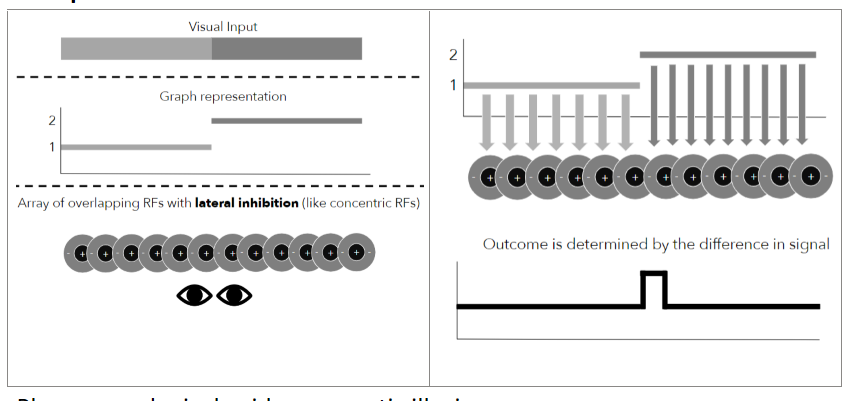
9
New cards
Conclude: RFs as filters or templates
As filters, they selectively respond to certain types of visual information, such as edges, lines, color, or motion. They work to filter out irrelevant information and focus on the specific type of visual information that the cell is sensitive to.
As templates, they provide a template or pattern that the visual system uses to recognize and understand specific visual features. For example, cells sensitive to edges may have a template for a specific edge shape or orientation, allowing the visual system to quickly recognize and interpret that edge in the visual scene.
Overall, receptive fields in the human visual system act as both filters and templates that work together to process and interpret visual information, allowing us to perceive and understand the world around us.
As templates, they provide a template or pattern that the visual system uses to recognize and understand specific visual features. For example, cells sensitive to edges may have a template for a specific edge shape or orientation, allowing the visual system to quickly recognize and interpret that edge in the visual scene.
Overall, receptive fields in the human visual system act as both filters and templates that work together to process and interpret visual information, allowing us to perceive and understand the world around us.
10
New cards
Thresholds for seeing: sight depends on?
* The properties of the eye, photoreceptors, ganglion cells, etc.,
* The inclination of the observer to respond, i.e. seeing is a property of the whole system, not just the eye.
* What do we “see”? Contrast? Intensity? Number of photons?
* The inclination of the observer to respond, i.e. seeing is a property of the whole system, not just the eye.
* What do we “see”? Contrast? Intensity? Number of photons?
11
New cards
Thresholds for seeing: Experimentation:
Hecht, Schlaer & Pirenne (1942)
* give the experimental design and task parameters
Hecht, Schlaer & Pirenne (1942)
* give the experimental design and task parameters
* ‘least’ was defined as the absolute minimum number of quanta of light that can be detected
* ‘seeing’ was defined arbitrarily as correct detection on 60% of trials
* Experimental design:
* Presented faint flashes of light to observer one at a time
* Observer report whether s/he sees the flash or not
* Experimenter adjusts the intensity of the flashes until the observer report seeing them 60% of the time
* Task parameters:
* Dark adaptation (wait for 40 minutes in the darkness)\*
* rods are far more sensitive than cones so optimise conditions for rod vision
* Position of the light on the retina (20 deg of retinal eccentricity - where rod density is maximum)
* The wavelength of the test light (wavelength of 510 nm - peak of rod spectral sensitivity)
* The size of the test flash (diameter of 10 arc min)
* The duration of the test flash (duration of 1 ms)
* ‘seeing’ was defined arbitrarily as correct detection on 60% of trials
* Experimental design:
* Presented faint flashes of light to observer one at a time
* Observer report whether s/he sees the flash or not
* Experimenter adjusts the intensity of the flashes until the observer report seeing them 60% of the time
* Task parameters:
* Dark adaptation (wait for 40 minutes in the darkness)\*
* rods are far more sensitive than cones so optimise conditions for rod vision
* Position of the light on the retina (20 deg of retinal eccentricity - where rod density is maximum)
* The wavelength of the test light (wavelength of 510 nm - peak of rod spectral sensitivity)
* The size of the test flash (diameter of 10 arc min)
* The duration of the test flash (duration of 1 ms)
12
New cards

Thresholds for seeing: Experimentation:
Hecht, Schlaer & Pirenne (1942)
* Give results
Hecht, Schlaer & Pirenne (1942)
* Give results
• 90 quanta (photons) reached the cornea
• estimated 3% reflected off cornea
• estimated 50% absorbed by the optic media (43
reached the back of the eye)
• estimated 20% absorbed by receptors (i.e. < 10 quanta)
=> \~10 rods need to be activated to be “seen” (tiny)
(evidence of pooling or convergence)
• estimated 3% reflected off cornea
• estimated 50% absorbed by the optic media (43
reached the back of the eye)
• estimated 20% absorbed by receptors (i.e. < 10 quanta)
=> \~10 rods need to be activated to be “seen” (tiny)
(evidence of pooling or convergence)
13
New cards
Thresholds for seeing: Experimentation:
Hecht, Schlaer & Pirenne (1942)
* Evaluate
Hecht, Schlaer & Pirenne (1942)
* Evaluate
Why is the function not sharp/ abrupt
* Due to noise (internal/ external)
* Internal:
* Spontaneous shape change of rhodopsin
* Fluctuations in blood pressure or blood oxygen levels
* Variations in spontaneous firing rate of interneurons
* External:
* *Fluctuations in photon emission in light filament (primary explanation)*
* Response bias may influence performance
* Consider signal strength, relevance, importance
* Liberal threshold- any signal may trigger response
* Conservative threshold- only specific signal may trigger response
* ‘Catch trials' with no light used to detect those too liberal (used by Hecht)
* Doesn't remove over-conservative participants
* What is seeing?
* 60% arbitrary threshold
* Would different threshold affect results
* Due to noise (internal/ external)
* Internal:
* Spontaneous shape change of rhodopsin
* Fluctuations in blood pressure or blood oxygen levels
* Variations in spontaneous firing rate of interneurons
* External:
* *Fluctuations in photon emission in light filament (primary explanation)*
* Response bias may influence performance
* Consider signal strength, relevance, importance
* Liberal threshold- any signal may trigger response
* Conservative threshold- only specific signal may trigger response
* ‘Catch trials' with no light used to detect those too liberal (used by Hecht)
* Doesn't remove over-conservative participants
* What is seeing?
* 60% arbitrary threshold
* Would different threshold affect results
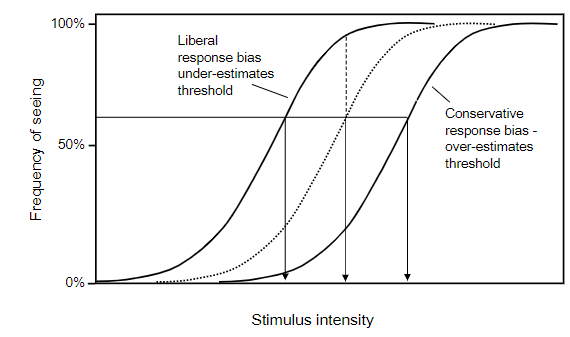
14
New cards
Thresholds for seeing: Experimentation:
Hecht, Schlaer & Pirenne (1942)
* Conclusions
Hecht, Schlaer & Pirenne (1942)
* Conclusions
**Conclusions**
* Visual system is extremely sensitive and noise free:
* One photon is sufficient to activate 1 rod
* Pooled responses of \~8 rods => “seeing” (60% detection)
* Despite exquisitely painstaking experimental controls, Hecht’s results are influenced by:
* The observer’s response bias
* The definition of seeing
* Visual system is extremely sensitive and noise free:
* One photon is sufficient to activate 1 rod
* Pooled responses of \~8 rods => “seeing” (60% detection)
* Despite exquisitely painstaking experimental controls, Hecht’s results are influenced by:
* The observer’s response bias
* The definition of seeing